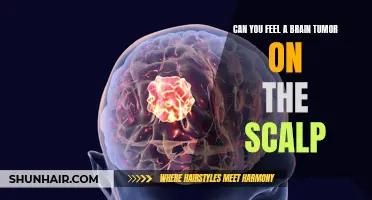
Imagine a scenario in which you were taken back in time, thrusted into the wilds of the American frontier, and suddenly found yourself at the mercy of a tribe of Native Americans. In an unfortunate turn of events, you become a victim of a brutal scalping, a devastating act in which your scalp is forcibly removed from your head. Now, in the midst of excruciating pain and with your life seemingly hanging by a thread, you may find yourself wondering: how long can you actually survive after being scalped? Walk with me as we delve into the fascinating world of survival against all odds.
What You'll Learn

Introduction: Understanding the Severity of Being Scalped
Scalping is a traumatic and life-threatening injury, with a long and gruesome history that dates back centuries. While it may be difficult to imagine surviving such a brutal act, medical advancements and prompt emergency intervention have increased the chances of survival in recent times. However, it is essential to understand the severity of being scalped to fully grasp the potential implications and long-term effects.
Scalping involves the forcible removal of the scalp, including the hair, skin, and underlying tissue, from the skull. This results in severe damage to blood vessels, nerves, and even the brain itself. The consequences can be devastating, ranging from profuse bleeding and shock to infection and long-term neurological deficits.
The severity of a scalping injury depends on various factors, including the extent and depth of the injury, the age and overall health of the victim, and the timeliness and adequacy of medical intervention. In cases where the injury is extensive, with significant tissue loss and damage to vital structures, the prognosis is often grave.
The primary concern in the immediate aftermath of a scalping injury is controlling bleeding and preventing shock. Emergency responders and healthcare professionals work swiftly to stop the bleeding by applying direct pressure, administering intravenous fluids, and transfusing blood if necessary. Once the patient is stabilized, they may undergo immediate surgical intervention to repair damaged blood vessels, reattach the scalp, and reconstruct the affected areas.
Despite the advancements in medical care, the long-term consequences of being scalped can be life-altering. Infections can occur due to the exposed nature of the injury, requiring aggressive antibiotic therapy and possibly surgical debridement. Scarring and disfigurement are common, and extensive rehabilitation may be necessary to regain motor and sensory functions.
Surviving a scalping injury is undoubtedly an immense achievement, but it is also crucial to understand that the journey to recovery is arduous and ongoing. Physical and psychological therapy may be required to address the emotional trauma and cognitive impairments that can arise from such a devastating event.
In conclusion, surviving a scalping injury is possible thanks to advancements in medical care and prompt intervention. However, the severity of being scalped cannot be underestimated. Immediate medical attention is essential to control bleeding and prevent shock, and long-term rehabilitation may be necessary to regain functional abilities. Understanding the severity of this injury is crucial for both medical professionals and the general public to appreciate the immense physical and emotional challenges faced by survivors of scalping injuries.
Understanding the Link Between Stress and Anxiety and the Itchiness of the Scalp
You may want to see also

Survival Rates: Examining the Factors Impacting Longevity
Survival rates after being scalped vary greatly depending on several factors. While this particular injury is severe and often life-threatening, medical advancements and prompt intervention have significantly improved outcomes for patients. In this article, we will explore the factors that impact longevity after a scalping injury and discuss the steps one can take to improve their chances of survival.
Immediate Medical Intervention:
The first and most crucial factor is receiving immediate medical attention. Scalping injuries are prone to severe bleeding, which can lead to hypovolemic shock or exsanguination. It is essential to call emergency services and provide basic first aid, such as applying direct pressure to the wound, to minimize blood loss. The speed at which medical professionals can control bleeding greatly influences the chances of survival.
Extent of the Injury:
The extent of the injury also plays a significant role in determining survival rates. Scalping injuries can vary in severity, from partial scalp avulsion to complete scalping, where the entire scalp is forcibly removed from the skull. The more extensive the injury, the higher the risk of complications such as infection, neurologic damage, or damage to underlying structures like blood vessels and nerves. The patient's overall health, age, and pre-existing conditions also contribute to the likelihood of survival.
Timely Surgical Intervention:
Once the patient reaches a medical facility, immediate surgical intervention is crucial. Surgeons will assess the injury and determine the appropriate course of treatment. In many cases, scalp reattachment is possible, primarily if the removed scalp tissue is intact and can be preserved. The surgery typically involves cleaning the wound, excising damaged tissue, and repositioning and securing the scalp using surgical techniques like sutures or tissue adhesive. This procedure aims to restore blood supply to the scalp and promote healing. Timely surgical intervention improves the chances of a successful reattachment and reduces the risk of infection and long-term complications.
Postoperative Care and Rehabilitation:
After the surgery, patients require careful monitoring and comprehensive postoperative care. Antibiotics may be prescribed to prevent infection, and pain management strategies will be implemented. Physical therapy may also be recommended to help restore muscle function and promote healing. Following the medical team's instructions regarding wound care, medication, and rehabilitation exercises is crucial to recovery.
Psychological Support:
Surviving a scalping injury can be physically and emotionally traumatic. Psychological support and counseling are essential components of the patient's recovery journey. Trained professionals can help patients and their families navigate the emotional challenges, address trauma-related symptoms such as anxiety or post-traumatic stress disorder (PTSD), and provide coping mechanisms for emotional healing and psychological well-being.
While a scalping injury is a severe medical emergency, prompt medical intervention, timely surgical reattachment, and comprehensive postoperative care can greatly improve survival rates. The extent of the injury and the patient's overall health also influence the chances of successful recovery. It is important to remember that every case is unique, and individual outcomes may vary. Seeking immediate medical attention, following professional medical advice, and ensuring psychological support during the recovery process are integral steps toward improving longevity after a scalping injury.
Understanding the Possibility of Cancerous Scalp Cysts: What You Need to Know
You may want to see also

Medical Interventions: Treatment Options and their Effects on Survival
Surviving a scalp injury, specifically a scalp avulsion or being scalped, is an extremely rare occurrence. These severe injuries are often the result of accidents, falls, or assaults, and they require immediate medical attention due to their potential life-threatening nature. In this article, we will explore the treatment options available for scalp avulsion and their effects on survival.
Scalp avulsion is a condition in which the scalp is completely torn away from the underlying tissue. This injury can result in significant bleeding, exposed skull bones, and even damage to the underlying blood vessels and nerves. When it comes to the treatment of scalp avulsion, time plays a critical role in determining the patient's chances of survival and the potential outcomes. Emergency medical care is absolutely crucial to ensure the best possible outcome.
The primary goal of treatment for scalp avulsion is to control bleeding, prevent infection, and restore blood flow to the affected area. Here are some of the medical interventions that may be employed in the treatment process:
- Immediate First Aid: The first step in treating a scalp avulsion is to apply direct pressure to the wound using a clean cloth or sterile dressing. This pressure helps to control bleeding until medical help arrives.
- Hemostatic Agents: Hemostatic agents, such as topical hemostatic dressings or powders, can be used to aid in controlling bleeding by promoting clotting. These agents can be applied directly to the wound to minimize blood loss.
- Surgical Intervention: Scalp avulsion often requires surgical intervention to repair the injury and reattach the scalp. The surgeon may perform a complex procedure known as microvascular replantation, which involves reconnecting the blood vessels and nerves to restore blood flow and sensation to the affected area.
- Wound Management: Proper wound management is essential in preventing infection and promoting healing. This may involve wound cleaning, debridement (removal of dead tissue), and application of sterile dressings. Antibiotics may also be prescribed to reduce the risk of infection.
- Pain Management: Patients with scalp avulsion may experience significant pain. Pain management strategies may include the use of analgesics or local anesthetics to alleviate discomfort during wound care or surgical procedures.
It is important to note that the chances of survival after scalp avulsion depend on several factors, including the severity and extent of the injury, the promptness of medical intervention, and the overall health of the patient. The longer the delay in receiving medical care, the higher the risk of complications and a poor outcome.
Additionally, even with early medical intervention, scalp avulsion injuries can have long-term effects on the patient's physical appearance, sensation, and functionality. Hair loss, scarring, and decreased sensation in the affected area are common complications.
In conclusion, surviving a scalp avulsion or being scalped is a rare occurrence that requires immediate medical attention. A combination of first aid, surgical intervention, wound management, and pain management is usually employed to maximize the chances of survival and promote the best possible outcomes. The timely administration of appropriate medical interventions remains vital for optimizing survival rates and minimizing long-term complications.
The Economic Analysis of Ticket Scalping: Can it be Justified?
You may want to see also

Rehabilitation and Quality of Life: Challenges Faced by Scalp Injury Survivors
Scalp injuries, including complete or partial scalping, can be both physically and emotionally devastating. These injuries often result from accidents involving machinery, motor vehicles, or traumatic incidents. Survivors of scalp injuries face unique challenges in their rehabilitation journey and the need for specialized care to regain functionality and improve their quality of life. This article aims to shed light on the rehabilitation process and address the challenges faced by scalp injury survivors.
Immediate Medical Intervention:
Immediate medical intervention is crucial in scalp injury cases to ensure that bleeding is controlled and prevent further damage. Emergency response teams employ measures to stabilize the patient and help minimize the impact on blood circulation and brain function.
Surgical Repair and Scalp Reattachment:
In many cases, surgical repair and scalp reattachment procedures are necessary to restore the scalp's functionality and appearance. Advanced microsurgical techniques may be employed to revascularize and reinnervate the scalp, promoting healing and minimizing the risk of complications.
Wound Care and Infection Prevention:
Proper wound care and infection prevention are essential during the recovery phase. Scalp injuries require regular cleaning, dressing changes, and monitoring for signs of infection. Healthcare professionals play a significant role in educating patients and caregivers on the appropriate techniques and practices to reduce the risk of complications.
Pain Management:
Scalp injuries can cause severe pain, both during the initial injury and throughout the healing process. Pain management strategies, including medication, physical therapy, and alternative therapies like acupuncture, may be employed to help alleviate pain and promote comfort.
Psychological Support and Counseling:
Survivors of scalp injuries often experience psychological distress, such as anxiety, depression, and body image issues. Access to psychological support and counseling services is vital to address these emotional challenges and help individuals cope with their new reality.
Physical Rehabilitation and Scar Management:
Physical rehabilitation is necessary to regain strength, range of motion, and functional abilities. Rehabilitation programs may include exercises, stretching, and techniques to improve mobility and enhance overall physical wellbeing. Scar management strategies, such as massages, silicone sheets, and laser therapy, may also be employed to minimize the appearance of scars.
Assistive Devices and Prosthetics:
In some cases, scalp injury survivors may require assistive devices or prosthetics to compensate for tissue loss or functional limitations. Wig prostheses or custom-made cranial prostheses can help restore a natural appearance and provide protection to the scalp.
Social Reintegration and Community Support:
Recovery from a scalp injury involves not only physical and psychological aspects but also social reintegration. Community support groups and peer counseling can be invaluable resources for individuals to connect with others who have faced similar challenges and share experiences, advice, and encouragement.
Rehabilitation and quality of life for scalp injury survivors require a multidisciplinary approach, involving medical professionals, therapists, and psychological support teams. By addressing the challenges faced by survivors, such as immediate medical intervention, wound care, pain management, psychological support, physical rehabilitation, and social reintegration, they can achieve optimal functionality, reduced pain, enhanced emotional wellbeing, and an improved overall quality of life. Through ongoing research and advancements in medical science, we continue to witness remarkable recoveries and improved outcomes for scalp injury survivors.
How Salt Can Benefit Your Scalp: The Benefits of Exfoliating with Salt
You may want to see also
Frequently asked questions
The survival rate after being scalped can vary depending on the severity of the injury and the promptness of medical intervention. Immediate treatment and surgical procedures can help improve the chances of survival.
After being scalped, various complications can arise, such as severe bleeding, infection, skull fractures, nerve damage, and potential brain injury. These complications can impact the overall prognosis and recovery process.
While recovery from being scalped can be a long and challenging process, it is possible to achieve partial or even full recovery, depending on the extent and severity of the injury, as well as the effectiveness of medical treatment and rehabilitation. However, scarring and long-term physical and psychological effects may still be present.







